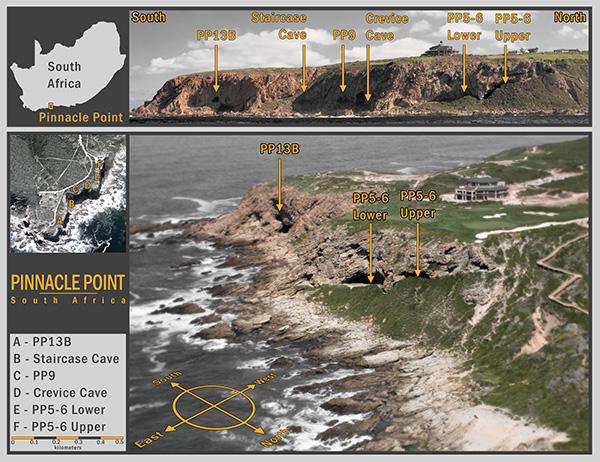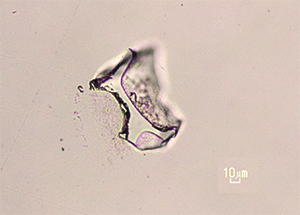Research shows humans thrived through Toba super-volcanic eruption

Pinnacle Point 5-6 cave interior using a total station to pinpoint items discovered during excavation. Photo by Curtis Marean
Imagine a year in Africa when summer never arrives. The sky takes on a gray hue during the day and glows red at night. Flowers do not bloom. Trees die in the winter. Large mammals like antelope become thin, starve and provide little fat to the predators (carnivores and human hunters) that depend on them. Then, this same disheartening cycle repeats itself, year after year.
This is a picture of life on earth after the eruption of super-volcano Mount Toba in Indonesia about 74,000 years ago. In a paper published this week in Nature, scientists show that early modern humans on the coast of South Africa thrived through this event.
The effect of the Toba eruption would have certainly impacted some ecosystems more than others, possibly creating areas, or refugia, in which some human groups did better than others throughout the event. Whether or not your group lived in such a refuge would have largely depended on the type of resources available. Coastal resources, like shellfish, were highly nutritious and less susceptible to the eruption than the plants and animals of inland areas.
Arizona State University researcher Curtis Marean has been studying an archaeological site at the southern tip of South Africa where there is evidence of this kind of human refuge during glacial periods, from around 195,000 to 130,000 years ago and again between 74,000 and 60,000 years ago. Marean is project director of the research site at Pinnacle Point in South Africa, associate director of ASU’s Institute of Human Origins and Foundation Professor in the School of Human Evolution and Social Change.
An eruption a hundred times smaller than Mount Toba — that of Mount Tambora, also in Indonesia, in 1815 — is thought to have been responsible for a year without summer in 1816. The impact on the human population was dire — crop failures in Eurasia and North America, famine and mass migrations. The effect of Mount Toba, a super-volcano that dwarfs even the massive Yellowstone eruptions of the deeper past, would have had a much larger, and longer-felt, impact on people around the globe.
The scale of the ash-fall alone attests to the magnitude of the environmental disaster. Huge quantities of aerosols injected high into the atmosphere would have severely diminished sunlight — with estimates ranging from a 25 to 90 percent reduction in light. Under these conditions, plant die-off is predictable, and there is evidence of significant drying, wildfires and plant community change in East Africa just after the Toba eruption.
If Mount Tambora created such devastation over a full year — and Tambora was a hiccup compared to Toba — we can imagine a worldwide catastrophe with the Toba eruption, an event lasting several years and pushing life to the brink of extinction.

The team has been excavating caves at Pinnacle Point, South Africa, for nearly 20 years. Glass shards were discovered at the PP5-6 location. Photo by Erich Fisher
When the column of fire, smoke and debris blasted out the top of Mount Toba, it spewed rock, gas and tiny microscopic pieces (cryptotephra) of glass that, under a microscope, have a characteristic hook shape produced when the glass fractures across a bubble. Pumped into the atmosphere, these invisible fragments spread across the world.

The shards at Pinnacle Point were carried nearly 9000 km from the source in Indonesia. Image by Erich Fisher
“I discussed the potential of finding the Toba shards in the sediments of our archaeological site with a colleague, and he found one,” Marean said.
Marean collaborated with Panagiotis Karkanas, director of the Malcolm H. Wiener Laboratory for Archaeological Science, American School of Classical Studies, Greece, who saw a single shard of this explosion under a microscope in a slice of archaeological sediment encased in resin.
“It was one shard particle out of millions of other mineral particles that I was investigating. But it was there, and it couldn’t be anything else,” Karkanas said.
The shard came from an archaeological site in a rockshelter called Pinnacle Point 5-6, on the south coast of South Africa near the town of Mossel Bay. The sediments dated to about 74,000 years ago.
Marean showed the shard image to Eugene Smith, a volcanologist with the University of Nevada at Las Vegas (UNLV), and Smith confirmed it was a volcanic shard.

The photo shows a volcanic glass shard erupted 74,000 years ago from the Toba volcano in Indonesia found at an archaeological site nearly 9000 km away at Vleesbaai, South Africa. Image credit Racheal Johnsen.
From scratch for this project and with National Science Foundation support, the international research team developed the Cryptotephra Laboratory for Archaeological and Geological Research based at UNLV, which is now involved in projects not only in Africa, but in Italy, Nevada and Utah.
Encased in that shard of volcanic glass is a distinct chemical signature, a fingerprint that scientists can use to trace to the killer eruption. In their paper, the team describes finding these shards in two archaeological sites in coastal South Africa, tracing those shards to Toba through chemical fingerprinting and documenting a continuous human occupation across the volcanic event.
ASU graduate student Jacob Harris designed a new statistical approach to determining the source location of the shards.
“Most studies of this type use very basic statistics to try to match the chemistry of the shards to the source volcano,” Marean said. “Jake used Bayesian modeling to build a statistical model to improve our analysis and strengthen the validity of our results.”
“Many previous studies have tried to test the hypothesis that Toba devastated human populations,” Marean noted. “But they have failed because they have been unable to present definitive evidence linking a human occupation to the exact moment of the event.
Most studies have looked at whether or not Toba caused environmental change. It did, but such studies lack the archaeological data needed to show how Toba affected humans.
The Pinnacle Point team has been at the forefront of development and application of highly advanced archaeological techniques. They measure everything on site to millimetric accuracy with a “total station,” a laser-measurement device integrated to handheld computers for precise and error-free recording.
Naomi Cleghorn with the University of Texas at Arlington, recorded the Pinnacle Point samples as they were removed.
Cleghorn explained, “We collected a long column of samples — digging out a small amount of sediment from the wall of our previous excavation. Each time we collected a sample, we shot its position with the total station.”
The sample locations from the total station and thousands of other points representing stone artifacts, bone and other cultural remains of the ancient inhabitants were used to build digital models of the site.
“These models tell us a lot about how people lived at the site and how their activities changed through time,” say Erich Fisher, associate research scientist with the Institute of Human Origins, who built the detailed photorealistic 3-D models from the data. “What we found was that during and after the time of the Toba eruption people lived at the site continuously, and there was no evidence that it impacted their daily lives.”
In addition to understanding how Toba affected humans in this region, the study has other important implications for archaeological dating techniques. Archaeological dates at these age ranges are imprecise — 10 percent (or 1000s of years) error is typical. Toba ash-fall, however, was a very quick event that has been precisely dated. The time of shard deposition was likely about two weeks in duration — instantaneous in geological terms.
“We found the shards at two sites,” Marean explained. “The Pinnacle Point rockshelter (where people lived, ate, worked and slept) and an open air site about 10 kilometers away called Vleesbaai. This latter site is where a group of people, possibly members of the same group as those at Pinnacle Point, sat in a small circle and made stone tools. Finding the shards at both sites allows us to link these two records at almost the same moment in time.”
The Vleesbaai site research was conducted by ASU anthropology doctoral graduate Simen Oestmo along with Jayne Wilkins of the University of Cape Town.
Not only that, but the shard location allows the scientists to provide an independent test of the age of the site estimated by other techniques. People lived at the Pinnacle Point 5-6 site from 90,000 to 50,000 years ago. Zenobia Jacobs with the University of Wollongong, Australia, used optically stimulated luminescence (OSL) to date 90 samples and develop a model of the age of all the layers. OSL dates the last time individual sand grains were exposed to light.
“There has been some debate over the accuracy of OSL dating, but Jacobs’ age model dated the layers where we found the Toba shards to about 74,000 years ago — right on the money,” Marean said.
This lends very strong support to Jacobs’ cutting-edge approach to OSL dating, which she has applied to sites across southern Africa and the world.
“OSL dating is the workhorse method for construction of timelines for a large part of our own history. Testing whether the clock ticks at the correct rate is important. So getting this degree of confirmation is pleasing,” Jacobs said.
In the 1990s, scientists began arguing that this eruption of Mount Toba, the most powerful in the last two million years, caused a long-lived volcanic winter that may have devastated the ecosystems of the world and caused widespread population crashes, perhaps even a near-extinction event in our own lineage, a so-called bottleneck.
This study shows that along the food-rich coastline of southern Africa, people thrived through this mega-eruption, perhaps because of the uniquely rich food regime on this coastline. Now other research teams can take the new and advanced methods developed in this study and apply them to their sites elsewhere in Africa so researchers can see how these devastating times affected other populations.
More Science and technology

Breakthrough copper alloy achieves unprecedented high-temperature performance
A team of researchers from Arizona State University, the U.S. Army Research Laboratory, Lehigh University and Louisiana State…

4 ASU researchers named senior members of the National Academy of Inventors
The National Academy of Inventors recently named four Arizona State University researchers as senior members to the prestigious…

Transforming Arizona’s highways for a smoother drive
Imagine you’re driving down a smooth stretch of road. Your tires have firm traction. There are no potholes you need to swerve to…

